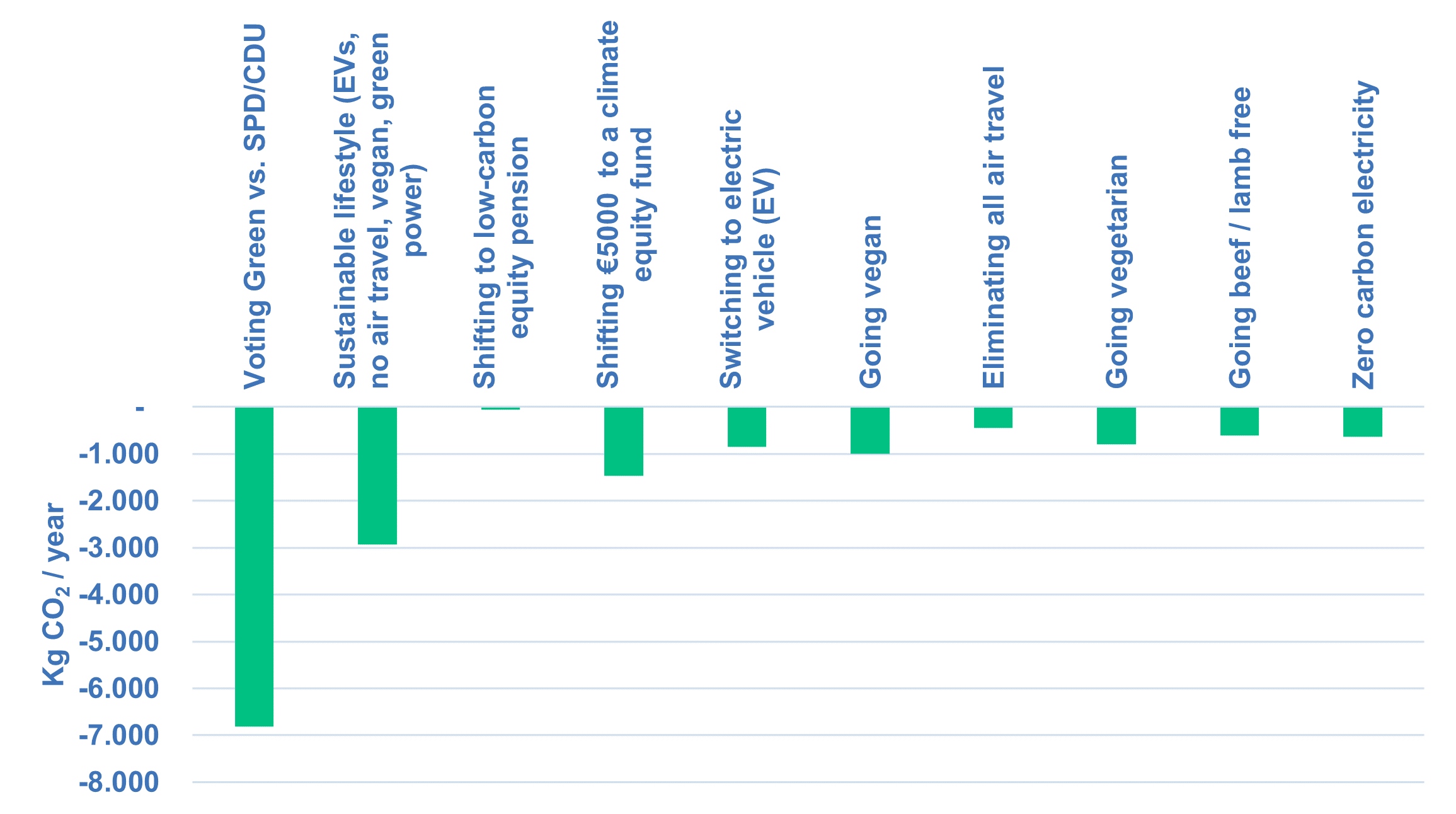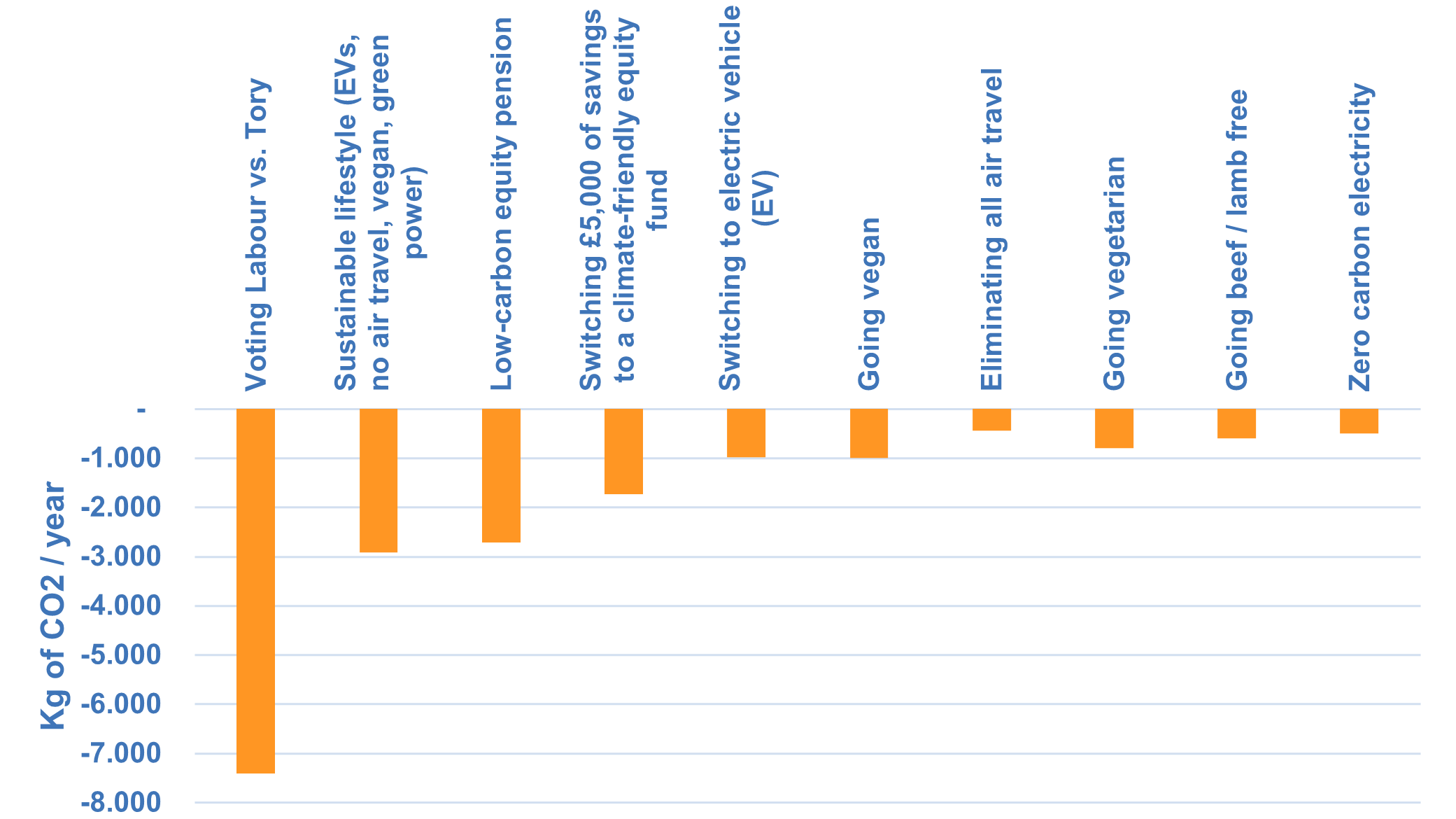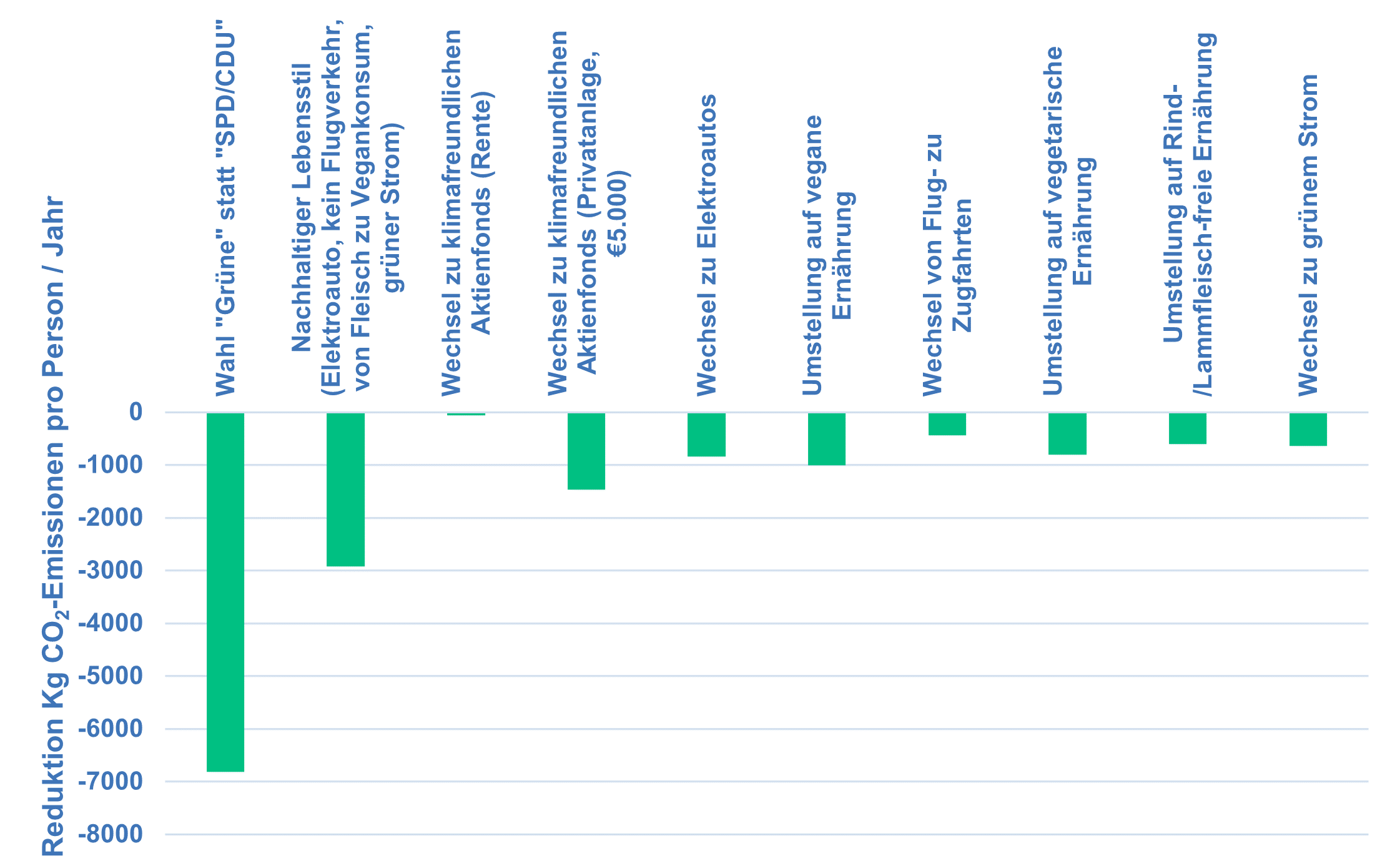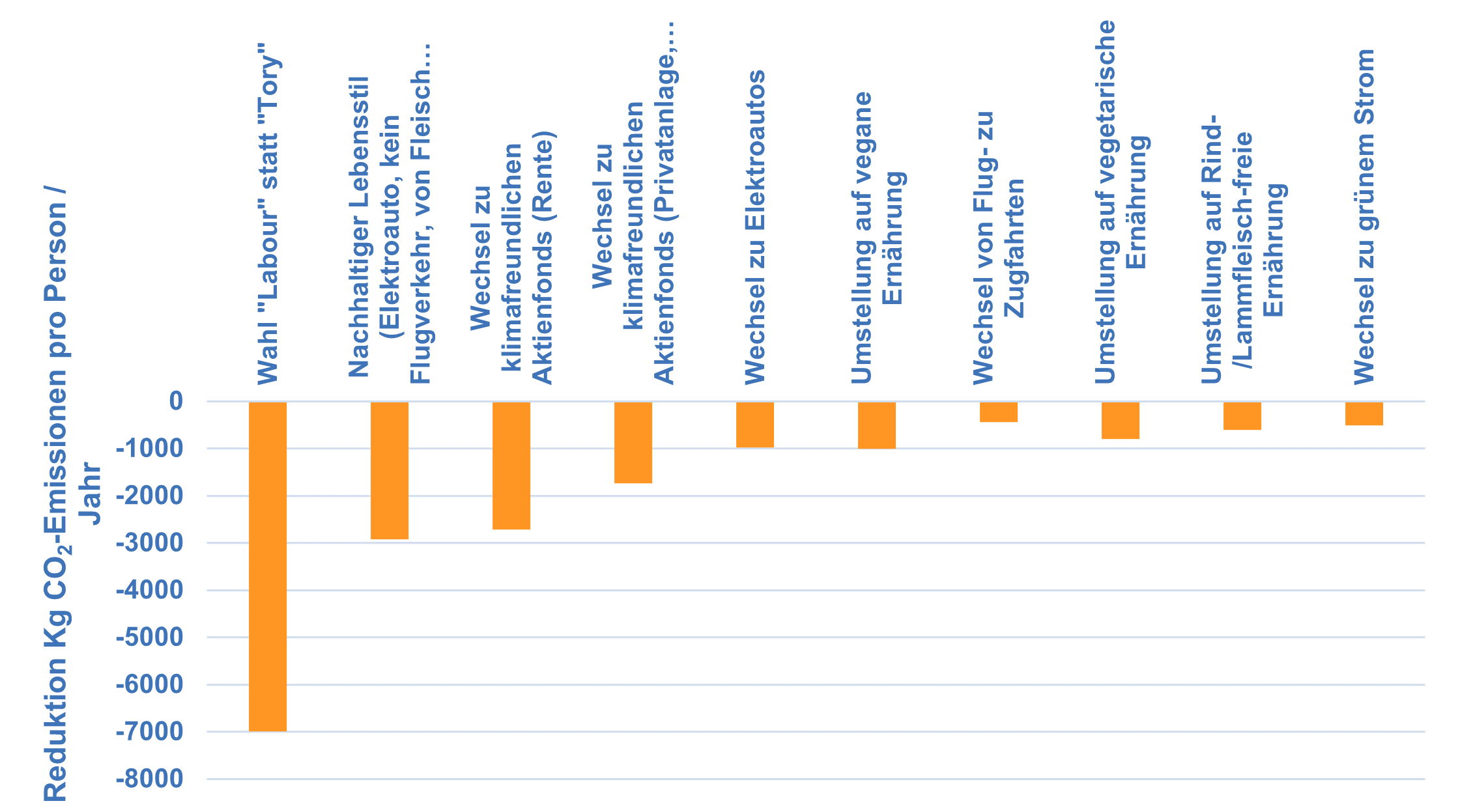Eine deutsche Textversion finden Sie unten
Voting for climate-friendly political parties in Germany & the UK could be the best way to minimize your carbon footprint
Ahead of German elections on September 26th, 2° Investing Initiative (2DII) finds in a new study that voting for climate-friendly parties can be the most important action a German or UK citizen can take to reduce their carbon footprint. While reducing your consumption footprint has a larger per capita effect than going to the polls, voting for a successful majority party can determine climate outcomes for the entire country. This makes voting the largest potential individual contributor to reducing the overall footprint of your voting, investment, and consumption choices.
2DII’s analysis finds that voting for a climate-friendly party can reduce the carbon footprint of an individual’s voting choice by almost 7,000 kgs of CO2 per year. This compares to around 2,900 kgs of CO2 per year through a combination of going vegan, switching to a zero-carbon electricity provider, cutting out air travel, and switching from a petrol to an electric car. A typical UK citizen will reduce an additional 2,700 kgs of CO2 per year by switching to a low-carbon equity pension plan.
A key driver of this outcome is the fact that changing consumption patterns will ‘only’ reduce your own footprint, while voting in elections can realize policies that change the footprint of an entire country – including for those voters that voted against climate policies.
Read the report (German) / (English)

Fig. 1: Differences in the emissions footprint of an individual in Germany related to voting, consumption, and investment choices (Source: Authors based on various sources, see Annex)

Fig. 2: Differences in the emissions footprint of an individual in the UK related to voting, consumption, and investment choices (Source: Authors based on various sources, see Annex)
More on the report & key qualifications
We recognize the risks and shortcomings of comparing different carbon footprints across different activities, and have written about the extent to which such comparisons can be problematic in the case of misleading environmental marketing claims. The study does not argue that people should choose one action over the other or that consumption choices should be ignored in favour of voting. Nor does it suggest that the carbon footprint is necessarily a proxy for your real world impact. Rather, it provides a way to think about the impact of different actions on your personal carbon footprint.
Crucially, reducing your own carbon footprint (whether it involves voting, consuming, or investing) does not necessarily translate into real-world emissions reductions. Voting for a climate-friendly party that doesn’t join the government reduces the personal carbon footprint of your voting behaviour, but not necessarily that of the country. The same is true for reducing the carbon footprint of your portfolio by simply selling high-carbon companies to other actors. The study explores the need for collective action in order to translate the reduction of a personal carbon footprint into real world changes.
Complementing this analysis, 2DII has also been working on ways to help consumers invest more sustainably. Last year, 2DII launched a free sustainable investing resource platform, MyFairMoney, which will be launched in the French and English markets later this year.
An attempt to extend carbon footprinting across voting, consumption, and investment choices
This study is the first attempt known to the authors to compare an individual’s carbon footprint across their voting, investment, and consumption choices as part of a single integrated exercise. While footprinting individual choices has a long track record in environmental accounting, so far this has largely been limited to consumption. However, individuals can affect climate outcomes in different ways, whether as voters, consumers, investors, etc. This study is an effort to tie these different strands together.
Jakob Thomae, lead author and Executive Director of 2DII Germany, said, “This study confirms the hypothesis that voting has the potential to be the most powerful decision a citizen can make to reduce their carbon footprint – and can be even more impactful than changes in consumption and investment habits. Given the small effort it takes to go to the ballot box every 4-5 years, it’s all the more reason for German citizens to exercise their voting rights this Sunday.”
About our funder: This report has received support from the Life NGO program under Grant No LIFE20 NGO/SGA/DE/200040. This content reflects the views of the author only, and the funders are not responsible for any use that may be made of the information it contains.

###
Die Wahl klimafreundlicher Parteien in Deutschland und Großbritannien könnte der beste Weg sein, um den eigenen Kohlenstoff-Fußabdruck zu minimieren
Im Vorfeld der Bundestagswahl am 26. September zeigt die 2° Investing Initiative (2DII) in einer neuen Studie, dass die Wahl klimafreundlicher Parteien die wichtigste Maßnahme sein kann, die Wählende in Deutschland und Großbritannien ergreifen können, um ihren CO2-Fußabdruck zu verringern. Während die Veränderung des eigenen Konsums einen größeren Pro-Kopf-Effekt hat als der Gang zur Wahlurne, kann die Stimmabgabe für eine erfolgreiche Mehrheitspartei die Klimaergebnisse für das gesamte Land bestimmen. Damit ist die Stimmabgabe der größte potenzielle individuelle Beitrag zur Reduzierung des Fußabdrucks Ihrer Wahl-, Investitions- und Konsumentscheidungen.
Die Analyse von 2DII zeigt, dass die Wahl einer klimafreundlichen Partei den CO2-Fußabdruck einer Person um fast 7.000 kg CO2 pro Jahr reduzieren kann. Im Vergleich dazu können rund 2.900 kg CO2 pro Jahr eingespart werden, wenn man sich vegan ernährt, zu einem kohlenstofffreien Stromanbieter wechselt, auf Flugreisen verzichtet und von einem Verbrenner- zu einem Elektroauto wechselt. Ein typischer Brite wird weitere 2.700 kg CO2 pro Jahr einsparen, wenn er im britischen Rentensystem, das stark auf private Vorsorge setzt, zu einem kohlenstoffarmen Aktienrentenplan wechselt.
Ein wichtiger Grund für den großen Einfluss des Wahlverhaltens ist, dass eine Änderung des Konsumverhaltens “nur” den eigenen Fußabdruck verkleinert, während die Stimmabgabe bei Wahlen politische Maßnahmen bewirken kann, die den Fußabdruck eines ganzen Landes verändern – auch für die Personen, die gegen die Klimapolitik gestimmt haben.
Bericht lesen (Deutsch)

Abb. 1: Unterschiede im CO2-Fußabdruck einer Einzelperson in Deutschland in Abhängigkeit von Wahl-, Konsum- und Investitionsentscheidungen (Quelle: Autoren auf der Grundlage verschiedener Quellen, siehe Anhang)

Abb. 1: Unterschiede im CO2-Fußabdruck einer Einzelperson in Großbritannien in Abhängigkeit von Wahl-, Konsum- und Investitionsentscheidungen (Quelle: Autoren auf der Grundlage verschiedener Quellen, siehe Anhang)
Mehr zum Bericht & Schlüsselqualifikationen
Wir sind uns der Risiken und Unzulänglichkeiten bewusst, die mit dem Vergleich unterschiedlicher CO2-Fußabdrücke verschiedener Aktivitäten verbunden sind, und haben in früheren Bericht bereits darüber geschrieben, inwieweit solche Vergleiche im Falle irreführender Umweltmarketing-Aussagen problematisch sein können. In der Studie wird nicht behauptet, dass Menschen eine Aktion der anderen vorziehen sollten oder dass Konsumentscheidungen zugunsten von Wahlen ignoriert werden können. Vielmehr bietet der Bericht eine Möglichkeit, über die Auswirkungen verschiedener Maßnahmen auf den persönlichen CO2-Fußabdruck nachzudenken.
Entscheidend ist, dass die Verringerung des eigenen CO2-Fußabdrucks (sei es durch Wahlen, Konsum oder Investitionen) nicht unbedingt zu einer realen Verringerung der Emissionen führt. Wer eine klimafreundliche Partei wählt, die nicht an der Regierung beteiligt ist, verringert zwar den persönliche CO2-Fußabdruck seines Wahlverhaltens, aber nicht unbedingt den des Landes. Das Gleiche gilt für die Verringerung des CO2-Fußabdrucks eines Portfolios dadurch, dass Anteile mit hohem Kohlenstoffausstoß an andere Akteure verkauft werden. Die Studie zeigt, dass kollektives Handeln in vielen Bereichen notwendig ist, um die Reduzierung des persönlichen Klima-Fußabdrucks in reale Veränderung umzusetzen.
Ergänzend zu dieser Analyse hat 2DII auch an Möglichkeiten gearbeitet, VerbraucherInnen zu helfen, nachhaltiger zu investieren. Vergangenes Jahr hat 2DII eine kostenlose Plattform für nachhaltiges Investieren ins Leben gerufen, MeinFairMögen, die noch in diesem Jahr auf dem französischen und englischen Markt gestartet wird.
Ein Versuch, den CO2-Fußabdruck auf Wahl-, Konsum- und Investitionsentscheidungen auszuweiten
Diese Studie ist der erste den Autoren bekannte Versuch, den Kohlenstoff-Fußabdruck einer Person über ihre Wahl-, Investitions- und Verbrauchsentscheidungen als Teil einer einzigen integrierten Analyse zu vergleichen. Die Ermittlung des Fußabdrucks individueller Entscheidungen hat zwar eine lange Tradition in der Umweltbilanzierung, war aber bisher weitgehend auf den Konsum beschränkt. Einfluss auf den Klimawandel nimmt man jedoch auch bei der Wahl und bei Investitionen. Die vorliegende Studie ist ein Versuch, diese verschiedenen Stränge miteinander zu verbinden.
Jakob Thomä, Hauptautor und Geschäftsführer von 2DII Deutschland, sagte: “Diese Studie bestätigt die Hypothese, dass die Stimmabgabe die mächtigste Entscheidung sein kann, die ein Bürger treffen kann, um seinen CO2-Fußabdruck zu reduzieren. In Anbetracht des geringen Aufwands, den es bedeutet, alle vier bis fünf Jahre zur Wahlurne zu gehen, ist das ein Grund mehr für die deutschen Bürgerinnen und Bürger, ihr Wahlrecht an diesem Sonntag auszuüben.”
Über unseren Geldgeber: Dieser Bericht wurde vom Life NGO-Programm unter der Förderungsnummer LIFE20 NGO/SGA/DE/200040 unterstützt. Der Inhalt gibt ausschließlich die Meinung des Autors wieder, und die Geldgeber sind nicht verantwortlich für die Verwendung der darin enthaltenen Informationen.



